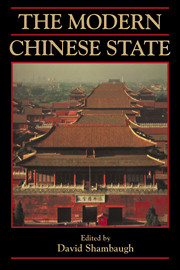Book contents
- Frontmatter
- Contents
- List of Contributors
- List of Illustrations
- List of Abbreviations
- Preface
- Introduction: The Evolving and Eclectic Modern Chinese State
- 1 The Late Imperial Chinese State
- 2 The Chinese State during the Republican Era
- 3 The Evolution of the State in the Republic of China on Taiwan
- 4 The Chinese State during the Maoist Era
- 5 The Chinese State in the Post-Mao Era
- 6 The Chinese Communist Economic State in Comparative Perspective
- 7 The Future of the Chinese State
- Index
Introduction: The Evolving and Eclectic Modern Chinese State
Published online by Cambridge University Press: 15 October 2009
- Frontmatter
- Contents
- List of Contributors
- List of Illustrations
- List of Abbreviations
- Preface
- Introduction: The Evolving and Eclectic Modern Chinese State
- 1 The Late Imperial Chinese State
- 2 The Chinese State during the Republican Era
- 3 The Evolution of the State in the Republic of China on Taiwan
- 4 The Chinese State during the Maoist Era
- 5 The Chinese State in the Post-Mao Era
- 6 The Chinese Communist Economic State in Comparative Perspective
- 7 The Future of the Chinese State
- Index
Summary
There are few issues that have interested China scholars over the years as the evolution of the Chinese state. As the following chapters illustrate, the Chinese state in the modern era has been a particularly dynamic entity. While it has evolved, the Chinese state has shed and absorbed a variety of organizational and normative features – becoming, over time, an eclectic amalgam.
CHINA'S ECLECTIC STATE
Unlike many Western polities that have evolved over the same period of time generally within a singular liberal paradigm, the modern Chinese state has undergone several macro transitions: from imperial to republican to revolutionary communist to modernizing socialist and, in Taiwan, to democratic phases. While radically different in its basic ethos and organizational structure in each phase (monarchical-republican-Leninistliberal), the Chinese state on the mainland has had three enduring missions: modernization of the economy, transformation of society, and defense of the nation against foreign aggression. The intended goals of social transformation varied (from neo-Confucianist to neofascist to radical Maoism to pragmatic Dengism), but for more than a century these have been the central and consistent missions of the Chinese state regardless of their fundamentally different cast. As one evolved to the next, some elements of the past survived each transition and were woven into new institutional frameworks. Each new departure was never total, although all were sharp and each sought to “overthrow” and replace the former. In reality, though, each new Chinese state maintained certain features of the old. Moreover, in each phase, different foreign elements were imported and grafted on to the evolving indigenous root, creating an ever-more complex hybrid.
- Type
- Chapter
- Information
- The Modern Chinese State , pp. 1 - 14Publisher: Cambridge University PressPrint publication year: 2000

